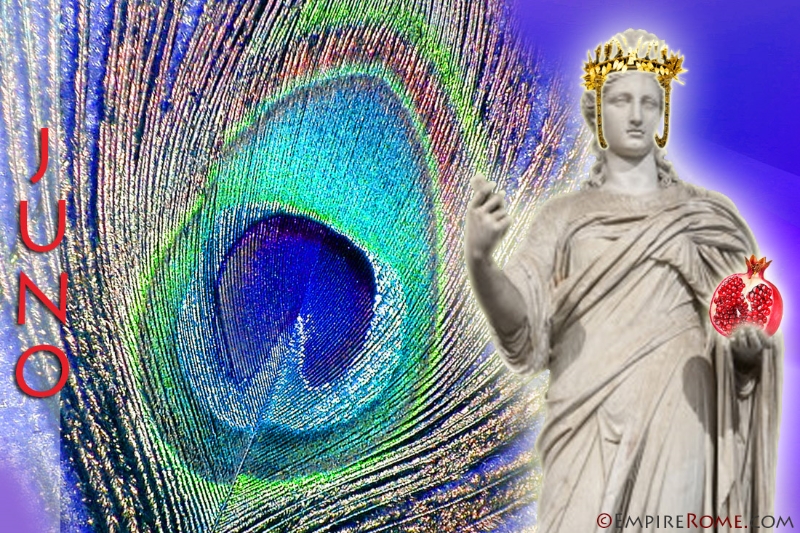
| JUNO “Queen of the Gods” | |
| God of: | Fertility, Marriage, and Pregnancy |
| Type: | Major |
| Roman Name: | Juno |
| Greek Name: | Hera |
| Other Names: | Juno Lucetia, Regina Coeli, Juno Moneta |
| Festivals: | July 1, September 13, and The Kalends, 1st of each month |
| Shrine/Temple: | Temple of Juno Moneta, Temple of Capitoline Jupiter (This temple dedicated to the Triad shared with Jupiter and Minerva) |
Overview
In Ancient Roman Religion, Juno was hailed as queen of the gods. She had powers that protected women and all things associated with fertility, pregnancy, and marriage. Generally, it is believed that Juno Regina derived from Uni—the Etruscan goddess before her.
Juno’s godly relations were quite interesting; she was Jupiter’s sister and wife. According to Ancient Roman mythology she gave birth to Vulcan, Mars, and Juventas. Jupiter, Juno’s husband, hurled lightning bolts through the sky, and like Jupiter, Juno was able to throw these lightening blots as well.
Juno was infamous for punishing gods, deities, and mortals, and the like for having affairs with her husband Jupiter. It is even said that Jupiter feared his wife Juno because her wrath was unyielding. Juno held marriage sacred and punished adulterers greatly.
Duties, Attributes, and Symbols
Juno had several epithets. An Epithet is descriptive phrases or words which have different meanings that are applied to divinities either as a description or in place of their actual name. Juno was called Juno Regina, protector of the Roman people. Juno Moneta another name given to her that stood for advisor to those about to marry, and Juno Lucina was goddess of childbirth and light for Ancient Roman women. One of Juno’s duties was to protect the mother during childbirth as the goddess Diana protected the infant. It should also be noted that Juno took on many other epithets throughout ancient Rome Juno was attributed to bringing the newly married wife home and removal of the bride’s girdle.
Other things Juno was associated with were more poetic descriptions such as bone setter or strengthener. Juno’s most famous characteristics were predominantly associated with women and child bearing.
Animals and plants sacred to Juno were the cow, peacock, pomegranate, water lily, and hawk.
Ancient Roman State
Juno was a highly renowned goddess who was attributed as protector and special counselor of the Roman state. Juno held other important state roles that involved structure and finances of the Ancient Roman Empire known as part of the Juno Moneta. In ancient Roman society Juno was seen as a mystical goddess. Like her Greek counterpart Hera, she was also known to be quite vengeful and spiteful if she was wronged in any way.
Capitoline Triad
Juno was part of the Capitoline Triad. The Capitoline Triad was a union of three Roman deities. The three gods that were part of this triune originally consisted of Jupiter god of thunder, Mars god of war, and Quirinus god of war from Sabine origin. Sabine was an Italic tribe that lived in ancient Italy.
It was believed by Etruscan influence that the Capitoline Triad later became Juno, Jupiter, and Minerva. The most important temples were dedicated to the Capitoline Triad. Ancient Romans built a great temple, the Capitolium on Capitoline Hill, which honored Juno, Jupiter, and Minerva. It was said to be one of Rome’s most beautiful and largest temples—although little remains of it today.
Festivals and Worship
Festivals for Juno were held on July 1, September 13, and The Kalends on the first of each month.
Fun Facts
Today our calendar uses the goddess Juno’s name in the month of June.
An asteroid in the asteroid belt is named Juno and is one of the most massive asteroids in the belt. Before being classified as an asteroid, Juno was previously believed to be a planet.
Click here to return to Ancient Roman Gods and Goddesses list.

